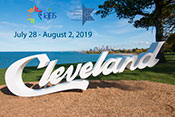Jewish Education
Few of the Jewish immigrants escaped the clash of cultures. While they gave their wholehearted support to the public schools and worked hard at becoming true Americans and assimilating into the American mainstream, they could not give up the spiritual values they brought with them. They strived to pass on to their children the traditional teachings of centuries. This meant schooling after public school hours in the Torah and the Talmud and Yiddishkeit. However, Jewish religious schools failed to attract more than a fraction of the immigrants' children. Responding to pressures for Americanization and assimilation they equated Hebrew learning and traditions, so vital to their parents, as foreignness.
Nevertheless, a variety of Cheders and Talmud Torahs (Hebrew Schools) sprang up, designed to give an elementary Jewish education to both boys and girls.
The Miriam Barnert Memorial Hebrew Free School -- Community Synagogue
The Miriam Barnert Memorial Hebrew Free School was founded in 1895
when a number of leading citizens recognized the need to provide a
free school for the religious training of Jewish children. Forty
pupils were enrolled and sessions were first held on the third floor
of the Smith and Jackson building on Market Street.
in 1902, after the death of his wife Miriam, Nathan Barnert deeded land at 176 Broadway for a school in her memory. The deed provided for a free school with daily instruction of Jewish children in the Hebrew Language, in the Old Testament, in Jewish history and religion, and the study of the Talmud. It further provided that religious services should be conducted in the school. Nathan Barnert served as president of the school from 1896-1927.
In 1961, a new building erected on 14th Avenue between East 28th and 29th Streets, was ready for occupancy for the High Holy Days. Since that time services to the members and the community have been greatly expanded, membership has increased, and a cemetery has been purchased.
Talmud Torah
The Talmud Torah, a Hebrew School for children who attended in the afternoon after their day in the public schools, was located at 42 Clinton Street near Water Streeet, in the center of a large Jewish concentration near the public schools, rental housing, the synagogue, and a Jewish retail commercial district. It held its first confirmation class in 1925. Later on it moved to a building at 11th Avenue and 25th Street, which it shared part-time with the Yavneh Academy (see below). It eventually merged with Yavneh Academy in 1950 and later moved with it to 377 12th Avenue. The earlier Talmud Torah building is still standing, across the street from P.S. 4.
Yavneh Academy
Yavneh Academy was founded as the Paterson Yavneh Yeshiva in 1942 with only six children registered in its kindergarten. For the first two years, classes met in a Graham Avenue storefront; later they shared a building with the Talmud Torah at 11th Avenue and 25th Street on a part time basis. In September 1950 the Talmud Torah was absorbed by Yavneh Academy. At that time, Yavneh Academy added an 8th grade and was now a complete elementary school with both Hebrew and secular departments. To accommodate its growing enrollment, a new Yavneh Academy building was purchased at 377 12th Avenue on the estate of former Governor John W. Griggs and dedicated in September 1954.
New classrooms and a primary grade wing were added in 1960 and 1976. To serve its growing suburban student population, in 1981 Yavneh purchased an existing school in Paramus on five acres of land with athletic facilities. A new cafeteria and six classrooms were added.
Today Yavneh's eight-year course equips students with a thorough knowledge of spoken and written Hebrew, Chumash with Rashi's commentaries, the minor Prophets, customs, traditions, religious observances, and Jewish and Israeli history. The secular program parallels that of the public schools and is fully accredited.
Workmen's Circle Jewish Children's School
A Workmen's Circle Children's School (also called the "Shula") opened in Paterson in 1921. First housed in empty store fronts, then in a former church at 12 Governor Street, the Shula later moved to the Labor Lyceum building of the Workmen's Circle. Five afternoons a week professional teachers, mostly from New York, taught Yiddish reading, history and literature. Since the school was secular, no religious ideology was taught.
Parents of the students were much involved in the running of the Shula and in planning fundraising affairs for its support.
From the 20's to the 40's the Shula flourished. But as the Jewish population moved out of Paterson, the Shula's enrollment diminished, and it became a 3-day a week school. Today, no Jewish Children's School exists in Paterson. However, the Workmen's Circle continues to sponsor a children's school in Hackensack.
The Yiddish Folk School
The Yiddish Folk School, located on Carroll Street near Graham Avenue, was a store front operation to teach children Yiddish and Jewish culture. The children learned to read and write in Yiddish. Mr. Kolka, nicknamed "Koka," was the entire operation, acting both as teacher and principal of the small non-religious school. Later the school moved to Carroll Street and Broadway.
Other Yiddish Schools
Other Shulas existed under the sponsorship of different ideological groups.
The International Workers Order Shula emphasized the awareness of social problems. The Yiddisher Arbeiter Farband Kinder Shula had a Labor Zionist orientation.
On the whole, they followed the Workmen's Circle School pattern, starting in storefront locations, developing Yiddish Language and Jewish culture curricula, yet remaining secular in nature. They flourished in the 1920's and declined in the 1950's and 1960's, when the Jewish population moved from Paterson to the suburbs.
Abraham M. Fabian Hebrew School (Temple Emanuel)
Temple Emanuel Hebrew High School
[To be completed at a later date.]
Sources:
Jews of Paterson (2012), p. 17-19, 26-28, 32-35
Our Paterson Jewish Heritage (1987), pp. 24-27

